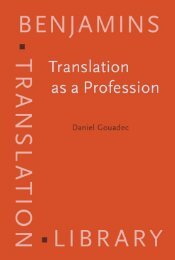Constructing a Sociology of Translation.pdf
Constructing a Sociology of Translation.pdf
Constructing a Sociology of Translation.pdf
- No tags were found...
Create successful ePaper yourself
Turn your PDF publications into a flip-book with our unique Google optimized e-Paper software.
12 Mirella Agorni“translated” in methodological terms by referring to the opposition between whatcan be broadly described as quantitative or descriptive models (focusing on patternsor regularities) and qualitative or explanatory approaches (focusing on thecontingent dimension <strong>of</strong> translation and the creativity <strong>of</strong> the human translator)(see Crisafulli 2002).It is essential not to confuse the distinction between descriptive and explanatorymodels with the well-known polemics opposing linguistic vs. cultural/literaryapproaches to translation studies, so <strong>of</strong>ten discussed by scholars such as MonaBaker (1996, 2001) and Lawrence Venuti (1998), for example. The dichotomyexplored by this article (descriptive vs. explanatory approaches) is not so muchtheoretical as methodological, and in some cases it can be found within one andthe same theory <strong>of</strong> translation. It is the case <strong>of</strong> Gideon Toury’s theoretical model,which is concerned, on the one hand, with the definition <strong>of</strong> translation normsand laws (here the emphasis is obviously on the discovery <strong>of</strong> regularities), while,on the other, it aims at formulating explanatory hypothesis, in order to investigatethe cultural role <strong>of</strong> translation (1995: 53).From a strictly methodological point <strong>of</strong> view, however, it seems possible todraw a distinction between descriptive translation approaches that emphasiseneutrality and objectivity in research (see for example Baker’s work on the universals<strong>of</strong> translation 1993 and 1995, or Toury’s insistence on norms 1995), asopposed to those highlighting issues such as translators’ agency and choices, andquestions <strong>of</strong> power and ideology (Bassnett and Lefevere 1998; Venuti 1995; CalzadaPérez 2003; Tymoczko and Gentzler 2002; etc.).In a paper that aims at a reassessment <strong>of</strong> the descriptive paradigm in translationstudies, Edoardo Crisafulli (2002) argues that the opposition amongst thekind <strong>of</strong> approaches which have just been described corresponds to a basic distinctionbetween empirical and hermeneutic research methods. In his opinion, however,such a distinction is more apparent than real, as all descriptive frameworksnecessarily depend on acts <strong>of</strong> interpretation.Even in the case <strong>of</strong> one <strong>of</strong> the most explicit empirical models <strong>of</strong> research intranslation, based on quantitative linguistic methods, that is the corpus-basedapproach to translation, it is impossible to draw a clear-cut distinction betweendescription and interpretation. Dorothy Kenny has amply demonstrated that thevery design <strong>of</strong> corpora is to be considered as an act <strong>of</strong> interpretation. As she putsit, the criteria governing the compilation <strong>of</strong> a corpus “will inevitably affect whatthe observer will notice” (Kenny 2001: 70).And yet the corpus-based model has something to say to all those interestedin the dilemma between quantitative or descriptive models and qualitative or explanatoryapproaches to translation. Kenny herself is working on such an issue ascreativity by using tools which would seem more appropriate for the investigation
















